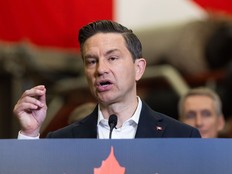MORICI: Trump’s tariffs speeding America down the road to recession

Article content
President Donald Trump’s election last November ignited expectations for strong growth for the U.S. economy. Trump pledged to bring Americans a leaner government, less regulation and lower taxes, along with building U.S. leadership in artificial intelligence. These goals helped push the U.S. stock market higher from last November through mid-February, extending two years of impressive gains.
Then came Trump’s tariffs.
In March, Wells Fargo economists estimated that a moderate tariff scenario, with proportionate retaliation from targeted nations, would subtract about half a percentage point from U.S. growth over the next two years.
However, the tariffs Trump announced on April 2 are far more aggressive than anticipated. While some nations are reportedly mulling tariff deals, China struck back with new levies on U.S. products. Both Wall Street and Main Street have been severely shaken.
Why be so fearful when the Trump administration says that everything will work out?
It comes down to perception. A president and his aides must appear steady and disciplined. Trump brandishing incoherent on-again-off-again tariff threats; abandoning World Trade Organization norms to impose aggressive tariffs; ruminating about annexing the Panama Canal, Canada and Greenland; pursuing a devil’s bargain with Russia to obtain Ukrainian minerals; and attacking judicial independence in the U.S. are anything but steady or disciplined.
Trump is being reckless when he tells Americans to endure some pain to get to his “golden age.” It’s reckless for Trump to say he can’t rule out a recession, given that expectations are paramount in a market-driven economy. No wonder many Americans are pessimistic.
Trump’s advisers aren’t comforting either. Treasury Secretary Scott Bessent and White House advisor Peter Navarro both say tariffs won’t be inflationary. Bessent predicted that tariffs would lower U.S. inflation to the Federal Reserve’s 2% target.
Surely, Trump’s team has seen the most recent U.S. consumer-price index report, which showed service-sector inflation clipping along at 4%.
Many questions are still unanswered. What will Trump’s tariffs achieve for the U.S.? Foreign policy and security concessions? Better market access? Additional revenue to pay for U.S. tax cuts? Where is Trump taking the U.S.? And what will be the shape of the new international order he seeks?
America’s competitive advantages are narrowing as China gains technological parity or leadership in more industries. The woes of U.S. businesses such as Boeing and Intel are a national emergency.
We hear plenty about China’s subsidies and its protected large market in autos. What about South Korea? Hyundai can make an electric sedan at a profit; General Motors and Ford can’t. U.S. automakers can’t even make gas-powered sedans at a profit — that’s why they’ve mostly quit that business.
Neither Trump’s tariffs nor former U.S. president Joe Biden’s industrial policies adequately address the fundamentals keeping American industries down — shortages of qualified workers, regulatory costs and so forth.
Trump can boost U.S. growth again by articulating a more reasonable tariff policy, cutting taxes and boosting the federal deficit. But increased spending risks higher inflation and interest rates, along with the U.S. dollar’s status as the world’s reserve currency.
With the U.S. government’s fiscal generosity having run its course and Trump promising stricter immigration policies, the pace of U.S. economic growth was bound to slow. But a recession was a remote possibility as of January. Then, The Wall Street Journal survey of economic forecasters expected modest U.S. growth of 2%. Even the prospects of aggressive tariffs on China and milder taxes on other imports didn’t sway economists; 20% of them responded that tariffs would add to year-over-year gross domestic product.
Now, however, the harsher-than-expected tariffs have raised fears of a U.S. recession. JPMorgan put the odds at 60%.
Chances are even greater that the U.S. economy would slog through two consecutive quarters of less than 1% growth. In that climate, stocks will continue to slide, and a prolonged bear market is likely.
Later this year or next, U.S. growth and stocks will likely start climbing back, but not with the outsized gains investors were enjoying before the madness of Trump 2.0.
Peter Morici is an economist and emeritus business professor at the University of Maryland











Postmedia is committed to maintaining a lively but civil forum for discussion. Please keep comments relevant and respectful. Comments may take up to an hour to appear on the site. You will receive an email if there is a reply to your comment, an update to a thread you follow or if a user you follow comments. Visit our Community Guidelines for more information.